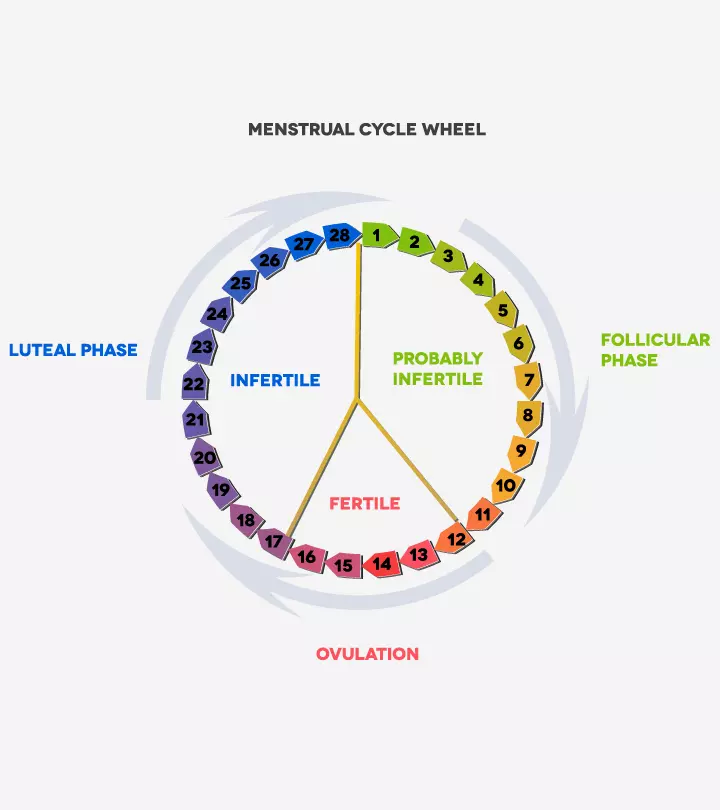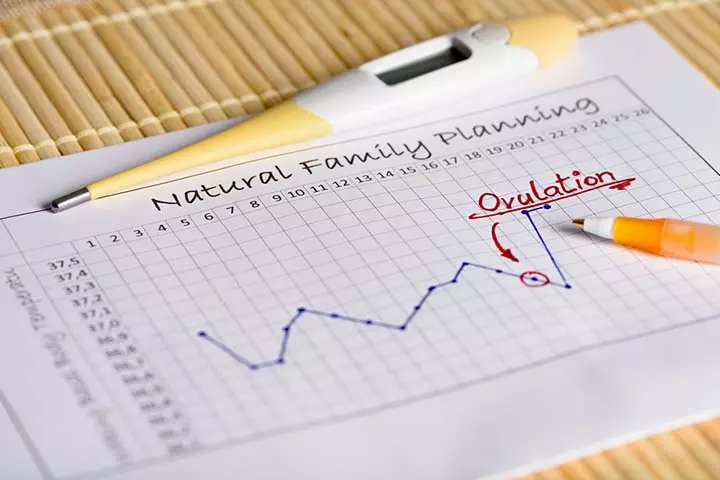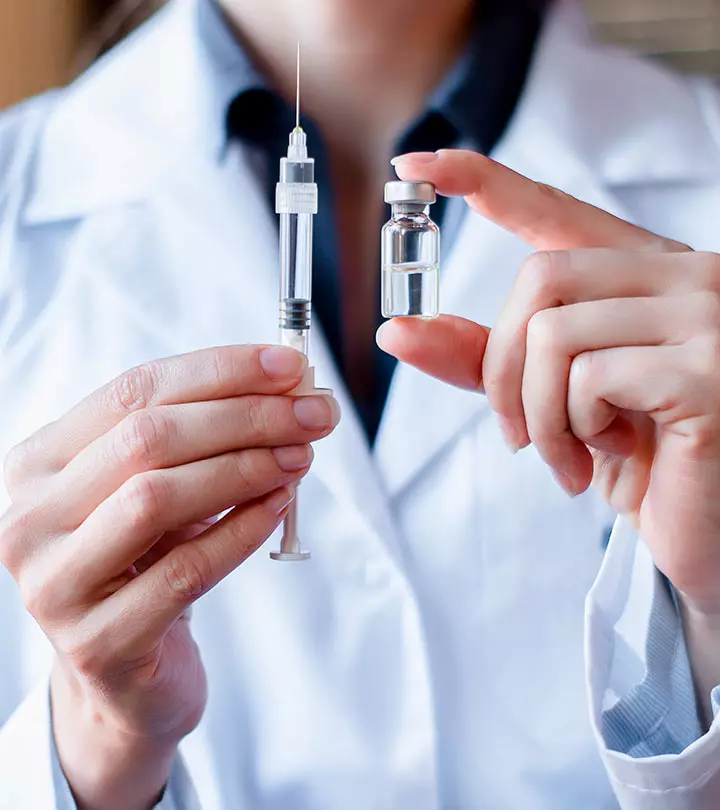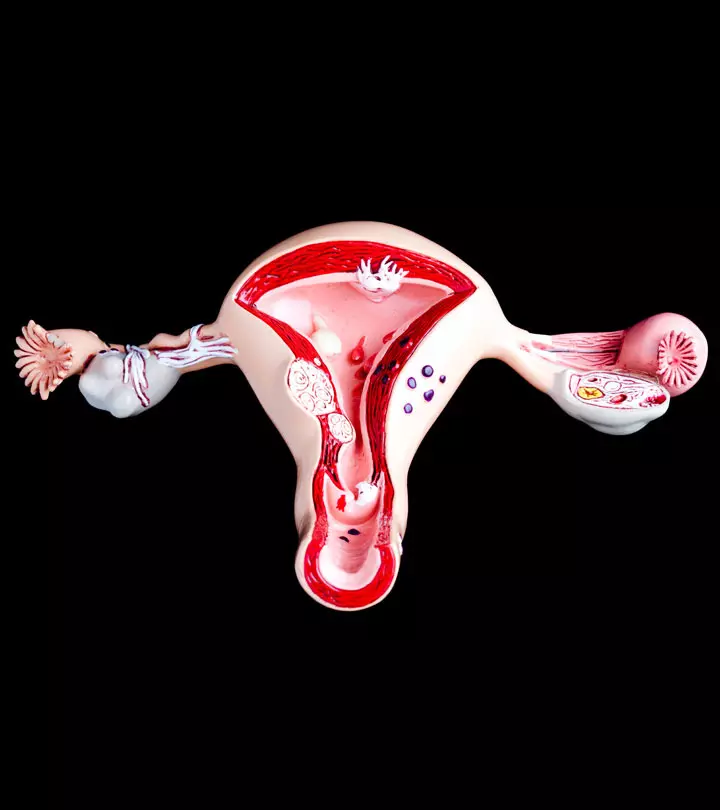
Image: ShutterStock
There are three phases of a menstrual cycle???the follicular, ovulatory, and luteal phases. The egg travels through the fallopian tubules during the three phases and attaches itself to the endometrial lining. Lack of fertilization leads to the shedding of the endometrial lining, which results in menstruation. Among the three phases, the third phase or the luteal phase has an important role to play during conception. This is why learning about the physiological and hormonal changes that occur during this period may help you conceive. Keep reading to know more about the luteal phase.

Key Pointers
- The luteal phase is a 14-day period during which the uterus prepares for pregnancy if fertilization occurs.
- Knowing your luteal phase can help you track ovulation after menstruation, aiding in pregnancy planning or prevention.
- Common signs of the luteal phase are bloating, mood swings, breast tenderness, and fatigue.
- Conditions such as anorexia, over-exercise, Polycystic ovary syndrome, and thyroid disorders can cause luteal phase defects.
- Appropriate medical care and a healthy lifestyle can aid in managing these defects.
What Is The Luteal Phase?
The period between ovulation and the onset of your next menstrual cycle is called the luteal phase.
In this phase, the follicle (released during the follicular follicular phaseiThe phase of the menstrual cycle characterized by the maturation of the egg in the ovaries ) converts into corpus luteum, a structure that produces the progesterone hormone in high amounts and some amounts of estrogen (1) (2).

How Long Is The Luteal Phase?
The normal menstrual cycle length is 21 to 35 days, of which the luteal phase lasts for about 14 days (3). The luteal phase is constant and fixed in most women. However, if your menstrual cycle is less than 25 days, then the luteal phase could be shorter.
The 14 days of the luteal phase is the time when the uterus in case of pregnancy prepares to house the fertilized egg.
After ovulation, the corpus luteum triggers the production of progesterone, which facilitates the thickening of uterus lining (endometrial lining) for the implantation of the fertilized egg.
After fertilization, the fertilized egg moves down into the womb from the fallopian tube and gets itself attached to the endometrium in the uterus (4). This process takes place during the luteal phase.
If fertilization does not occur, shrinkage of the corpus luteum causes a drop in the progesterone secretion, and the uterine lining sheds, leading to menstrual bleeding. This results in your next menstrual cycle.
A healthy luteal phase is important for keeping the uterine lining intact and creating a supportive environment for embryo implantation. Women trying to conceive may want to track how long their luteal phase lasts to improve their chances of getting pregnant. It helps you track the ovulation period after a menstrual cycle. Knowing how long ovulation lasts helps you time plan conception. Thus, calculating the ovulation date and three days before and after it can help you plan/ avoid pregnancy.
How Is Ovulation Calculated?

A hormone-specific blood test can help identify the ovulation and start of your luteal phase. Alternatively, you may track your cycle for around six months, and observe the pattern to calculate your luteal phase.
Another way is to use BBT charting. Your basal body temperature (BBT) increases during the time of ovulation and remains high until your next period starts. You can track your temperature from the beginning of the menstrual cycle and notice the rise in BBT. The elevation in the body temperature confirms ovulation (3).
Here is the formula for calculating the ovulation time through the luteal phase.
- Day of ovulation = length of menstrual cycle – length of luteal phase
For example, let’s assume that for a 28-day cycle, the luteal phase lasts for 14 days. Putting the respective values in the formula gives you the day of ovulation:
28 (length of the cycle) -14 (length of the luteal phase) = 14. It means, the 14th day of your menstrual cycle is your ovulation day.
An ovulation prediction calculator or kit may also help you identify the ovulation day and thus the luteal phase.
Your body goes through some changes during the luteal phase.
What Are The Changes In Your Body During Luteal Phase?
The increase in the progesterone levels during this phase can lead to the following changes in your body:
- Tenderness of breasts and nipples
- Mood swings
- Bloating
- Fluid retention
- Anxiety
- Tiredness
- Stomach cramps, which can sometimes feel like menstrual cramps
These changes during the luteal phase are common and do not, in any way, affect your chances of getting pregnant.
What Is A Luteal Phase Defect?

The insufficient release of progesterone during the luteal phase is termed as luteal phase defect (LPD) or luteal insufficiency. This defect will prevent the thickening of the uterus lining resulting in inappropriate embryo implantation. It lowers the chances of sustaining a pregnancy (5). However, it is not clear if LPD is a reason for infertility (6).
The luteal phase defect can result of the following:
- Defective functioning of the corpus luteum resulting in the lower secretion of progesterone and estradioliA steroidal female sex hormone vital for maintaining the reproductive system .
- The inability of the uterine lining to respond to the proper levels of progesterone and estradiol.
 Quick fact
Quick factThese defects or menstrual disorders could happen due to:
- Break down of the corpus luteum
- Defect in ovulated egg
- An unruptured follicle (this happens when the luteinizing hormone is not sufficient to rupture the follicle)
- AnorexiaiA psychological eating disorder that causes people to obsess about their weight and food
- Over-exercise
- EndometriosisiA condition in which tissues similar to the uterine lining (endometrium) grow outside the uterus
- Obesity
- Polycystic ovary syndromeiA condition where ovaries produce excess male hormones, leading to infertility, excess hair growth, and irregular periods
- Hyperprolactinemia (excess production of a hormone that makes breast milk)
- Thyroid disorders
 Things to know
Things to knowWomen who experience LPD have their periods earlier than the usual date. The LPD leads to a shorter menstrual cycle, where the luteal phase is less than nine days because of the lower production of progesterone. The defect manifests through other symptoms as well.
What Are The Symptoms Of Luteal Phase Defect?
Menstrual irregularities may indicate an abnormal luteal phase. The symptoms of luteal phase defect include:
- Getting menstrual cycles earlier than normal
- Spotting in between periods
- Miscarriages
LPD is not immediately recognized and requires a diagnosis to identify and treat the problem.
How Is Luteal Phase Defect Diagnosed?
LPD does not have any validated clinical diagnostic methods. However, the below tests are usually done for the purpose:
1. Blood tests to analyze:

- Follicle-stimulating hormone (FSH), which regulates the ovarian function (this hormone is released by the pituitary gland).
- Luteinizing hormone that triggers ovulation.
- Progesterone that stimulates thickening of the uterine lining.
Progesterone that stimulates thickening of uterine lining
 Quick tip
Quick tip2. Ultrasound:
It checks the thickness of the uterine lining. Additionally, it can help assess the condition of key organs in the female reproductive system, including the ovaries, uterus, fallopian tubes, and cervix.
2. Endometrial biopsy:
Although this method has failed to prove any correlation between luteal phase defect and fertility, it is still considered one of the best methods for LPD diagnosis. It is typically done one or two days before the onset of periods. During this test, a small sample of the endometrial lining is collected and examined under a microscope to check the thickness of the lining.
The doctor may use a combination of tests to confirm it is LPD, and then the treatment follows.
What Are The Treatment Options For LPD?
The treatment for LPD depends on the underlying cause. The doctor may suggest one of the below options (5):
- Clomiphene citrate (Clomid) or human menopausal gonadotropins (hMG) stimulate the ovaries to produce more follicles, which in turn release more eggs. The medicine is usually administered on the third to seventh, or fifth to ninth day of your menstrual cycle, depending on how long or short it is.
- Human chorionic gonadotropin (hCG) triggers ovulation. This is called the gonadotropin therapy in which the hCG is administered to trigger ovulation and extend the luteal phase (7).
- Progesterone supplements help in stimulating the growth of the uterus lining. These supplements are given after ovulation for ten days or until eight to ten weeks of gestation. The supplements can be in the form of injections, pills or suppositories.
The treatment focuses on increasing the progesterone hormone in the body so that the luteal phase is extended. You may complement the treatment with the right diet and routine.
How To Increase The Length Of Luteal Phase?
A healthy lifestyle helps you avoid several gynecological problems, including LPD. It is necessary, especially if you are planning for pregnancy. Here is what you can do:
1. Have a balanced diet by including:
- Vitamin B6 rich foods such as banana and salmon
- Vitamin B complex
- Green leafy vegetables
- Vitamin C rich foods such as broccoli, papaya, Brussel sprouts, etc.
2. A potent herb called vitex (chasteberry) has been used since ages to treat luteal phase defects in women. You may take it in the form of capsules with a dosage of 30-45mg or 40 drops of liquid extract mixed with water. However, do not use it unless your doctor gives you the go-ahead.
3. Acupuncture helps regulate the menstrual cycle, which in turn increases the luteal phase (8). Consult a qualified acupuncturist, who can help you with the treatment.
Frequently Asked Questions
1. Can I get pregnant in the luteal phase?
Yes, since the luteal phase is the period when you start ovulating, your body starts producing hormones to support a pregnancy in case the released egg is fertilized. Hence, you may plan to get pregnant during the luteal phase (9).
2. What does discharge look like during the luteal phase?
You may notice dry, thick, and white cervical mucus before ovulation that turns slippery and clear right before ovulation (10).
3. What is the role of progesterone in the luteal phase, and what happens if levels are too low or too high?
Progesterone plays a crucial role in the luteal phase. It helps maintain the uterine lining and promotes a supportive environment for embryo implantation. If progesterone levels are too low, the endometrium may not develop adequately, resulting in difficulty achieving or maintaining pregnancy (6). On the other hand, if progesterone levels are excessively high, it may be a sign of adrenal gland disorder (12).
4. How does the luteal phase impact fertility, and what are some ways to optimize it for conception?
When ovulation is irregular or absent, it can result in a shortened or insufficient luteal phase, making conception challenging (6). However, adopting a healthy lifestyle, which includes a balanced diet, regular exercise, and stress management, may positively influence the luteal phase and reproductive health in general (13).
5. How can lifestyle factors such as diet, exercise, and stress affect the luteal phase and overall reproductive health?
A balanced diet rich in nutrients supports hormonal balance and overall well-being. Regular exercise can help regulate hormone levels (13). Stress can disrupt hormone production and affect ovulation and the luteal phase (14). Managing stress through relaxation techniques and self-care may be beneficial for reproductive health.
6. What is the relationship between the luteal phase and miscarriage, and what are some ways to reduce the risk of miscarriage?
If there are abnormalities or deficiencies in the luteal phase, such as a luteal phase defect (LPD) characterized by inadequate progesterone production, it can increase the risk of early pregnancy loss (15). Other ways to reduce the risk of miscarriage include maintaining a healthy lifestyle, early prenatal care, managing chronic conditions, and considering genetic counseling if needed.
Luteal phase defect is not likely to be a reason for infertility. However, the phase plays a vital role in conception. Therefore, you should get a checkup if you plan to conceive but have gynecological issues, such as irregular periods, spotting, or short menstrual cycles. Upon the diagnosis, the doctor may recommend the necessary treatment to treat the underlying cause of LPD. Prompt medical intervention might help you get pregnant sooner without complications. Also, following a balanced diet, acupuncture can help manage the defect and lengthen the phase.
Infographic: Conditions Causing Defective Luteal Phase
The luteal phase is an important part of the menstrual cycle. However, defects of the luteal phase may occur due to the corpus luteum’s improper functioning or the uterine lining’s inability to respond to progesterone and estradiol levels. Check out the infographic below to learn about various factors and conditions that may cause a defective luteal phase.

Illustration: Momjunction Design Team
Learn about luteal phase deficiency and how it affects ovulation and progesterone levels in females. Discover the causes and treatments for this condition in this informative video.
References
- Ovulation Better Health Channel.
https://www.betterhealth.vic.gov.au/health/conditionsandtreatments/ovulation - Luteal Phase
https://my.clevelandclinic.org/health/articles/24417-luteal-phase - Beverly G Reed et al.; (2018); The Normal menstrual cycle and the control of ovulation National Library Of Medicine.
https://www.ncbi.nlm.nih.gov/books/NBK279054/ - Charting your menstrual cycle Our bodoes ourselves.
https://ourbodiesourselves.org/health-info/charting-your-menstrual-cycle - Luteal Phase defect Regional One Health.
https://www.regionalonehealth.org/womens-services/ - Tolga B. Mesen and Steven L.Young; (2015); Progesterone and the Luteal phase NIH.
https://www.ncbi.nlm.nih.gov/pmc/articles/PMC4436586/ - The luteal phase during gonadotrophin therapy: effects of two human chorionic gonadotropin regimens.
https://www.fertstert.org/article/S0015-0282(16)54357-X/fulltext - Luteal phase defect.
https://bostonchineseacupuncture.org/infertility-acupuncture/luteal-phase-defect/ - The menstrual cycle.
https://crh.ucsf.edu/about-fertility/normal-menstrual-cycle - Cervical mucus.
https://my.clevelandclinic.org/health/body/21957-cervical-mucus - Diagnosis and treatment of luteal phase deficiency.
https://www.asrm.org/practice-guidance/practice-committee-documents/diagnosis-and-treatment-of-luteal-phase-deciency-a-committee-opinion-2025/ - Progesterone Test.
https://medlineplus.gov/lab-tests/progesterone-test/ - Nutrition and Exercise Throughout Your Menstrual Cycle.
https://health.clevelandclinic.org/nutrition-and-exercise-throughout-your-menstrual-cycle - Karen C. Schliep et al.; (2016); Perceived stress, reproductive hormones, and ovulatory function: a prospective cohort study.
https://www.ncbi.nlm.nih.gov/pmc/articles/PMC4315337/ - Duru Shah and Nagadeepti Nagarajan; (2013); Luteal insufficiency in first trimester.
https://www.ncbi.nlm.nih.gov/pmc/articles/PMC3659905/
Community Experiences
Join the conversation and become a part of our nurturing community! Share your stories, experiences, and insights to connect with fellow parents.
Read full bio of Dr. Mozhgan Sayyad
Read full bio of shreeja pillai
Read full bio of Rebecca Malachi
Read full bio of Dr. Joyani Das

















